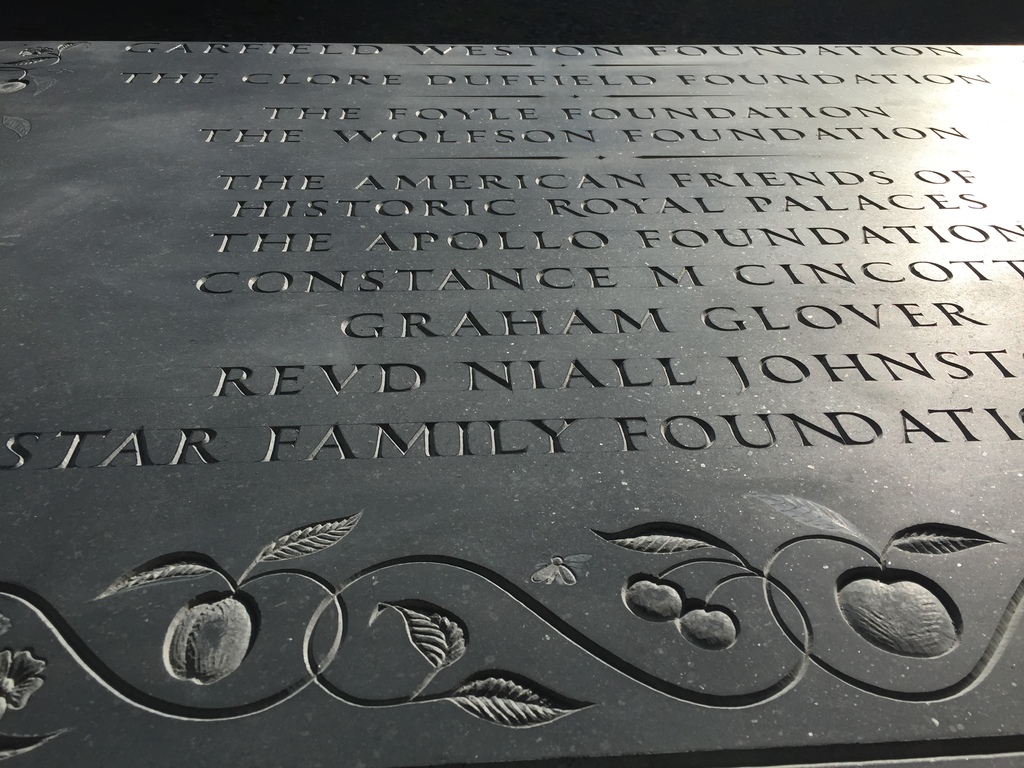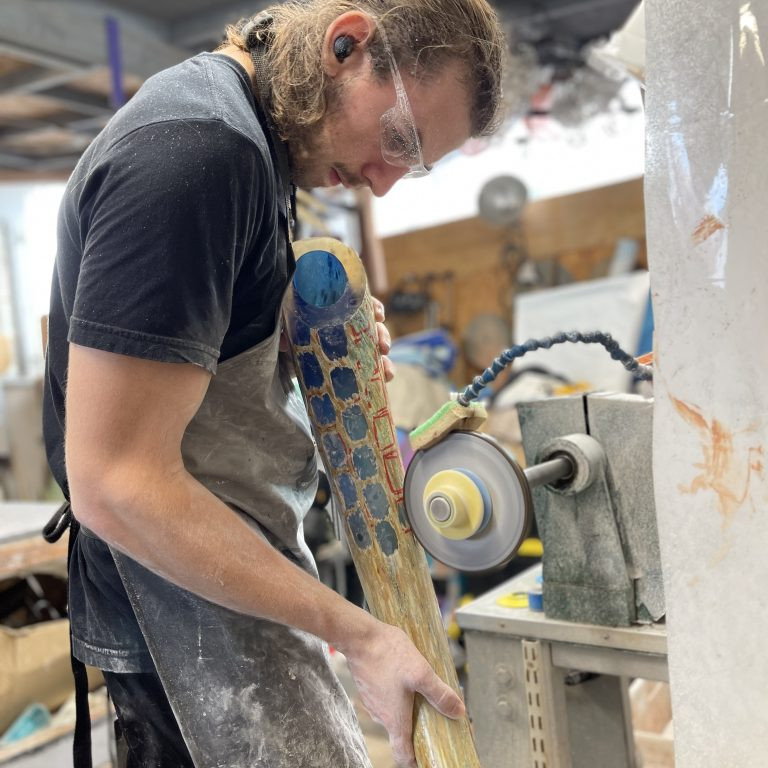Richard Healy Sculptor
Your work is divided in two parts, as a Sculptor and Memorial artist.
Which came first?
I studied fine art sculpture at the National College of Art and Design in Dublin and graduated in 2000. I started looking for work straight away. When you leave art college, you find yourself without any of the support structures you were used to, such as access to machinery, space to work or technicians, I think this is especially true if you are a sculptor.

In a Nut Shell
You’re kind of tossed out on your ear and you have to start from scratch…. No tools, no studio, and no money. So I went to work in a small foundry for about six months, to learn some practical skills and knowledge in casting bronze…
One evening the phone rang and a stone sculptor called Thomas Glendon was on the line. I had met Thomas during a stone carving workshop at college. He said he had some large blocks of stone in his studio, yard and he wanted to know if I was interested in doing some work for him. I jumped at the chance… and there began an unexpected life in stone. I quickly grew to love stone carving and all the elements of it, such as the tools, especially forging our own and tempering, I also enjoyed the physicality of stone carving. I learned the discipline involved in seeing your way through a carving, from the maquette stage, marking up the block, making templates to the wasting stages and the fine carving and finishing. I always count myself really lucky to have been presented with this opportunity, to accidentally become a stone sculptor in this way.
Tom was a sculptor and Letter carver so this meant the array of work coming into his studio was varied and interesting. One day you could be carving an Altar block or a baptismal font, the next you could be working on one of Tom’s sculptural pieces or shaping a headstone or something else.
I worked for Tom full time for about 4 years and got a really great apprentice style training from him. I think one of the most important things I took from my time there was seeing that you could be a professional artist and how to go about it. I worked on projects for Tom on and off for the next few years between doing my own work and commissions and setting up my own practice at D15 studios in Dunsink, Dublin near the old Dunsink Observatory.
So going back to your question about the memorial side of my practice, all that time I had spent surrounded by large inscriptions on headstones and memorials and watching how they were set out and how to lay out inscriptions. From choosing letter forms to work with or an appropriate stone type, spacing, and the rhythm of a piece all informed my own practice.
Once I had moved into my new studio I was also very lucky to share it with another stone sculptor called Stephen Burke who had studied Architectural stone carving in the City and Guilds in London. Stephen brought a great formal training back from the UK and we have been sharing our D15 studio for the last 15 years. The shared space of our D15 studio has been a really nourishing environment for creating work, sculptural and memorial.
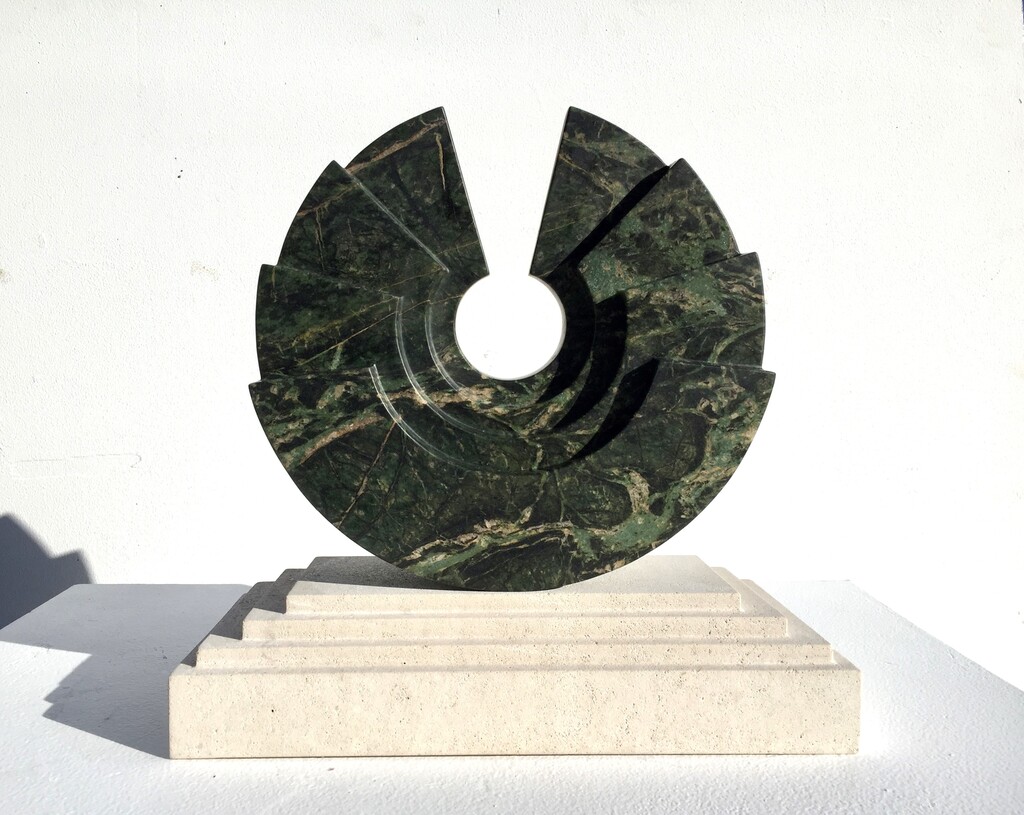
Again back to the question, Sculpture first and memorial work followed that. Both are extremely important to my practice. My fine art sculptural work is often done for myself, with a view to exhibit the work but the memorial work has an equally important role to play. It brings a kind of discipline to my practice. Not that I’m undisciplined, but rather a formal side or return to basics.
Does your memorial work need you to spend more time with the client?
Deciding on the body of text is one of the most important things to be considered with a memorial. There can be a lot of discussion with a client over this and it can be tough on folks because they have often lost someone very close to them. In some ways the memorial or headstone can be the hardest part of the grieving process because it gives a sense of closure or finality.. and the sentiment is a personal choice, it can be hard to decide on. I lean towards a less is more approach but once it is decided upon, you can start to lay out the text.

Cut letter close up
With an inscription there is a hierarchy of information such as names and dates, that sort of thing….. you also have style choices and what letterform is appropriate and spacing considerations.. The aim is to create a piece that has a balance to it.
If it happens to be a headstone you will have a certain amount of parameters, normally cemeteries have height restrictions etc and it is your job to create a balanced headstone within these set sizes. Sometimes the client will be leaning towards a stone or letterform they have seen somewhere else and this can be helpful to give you a start or a direction to follow.
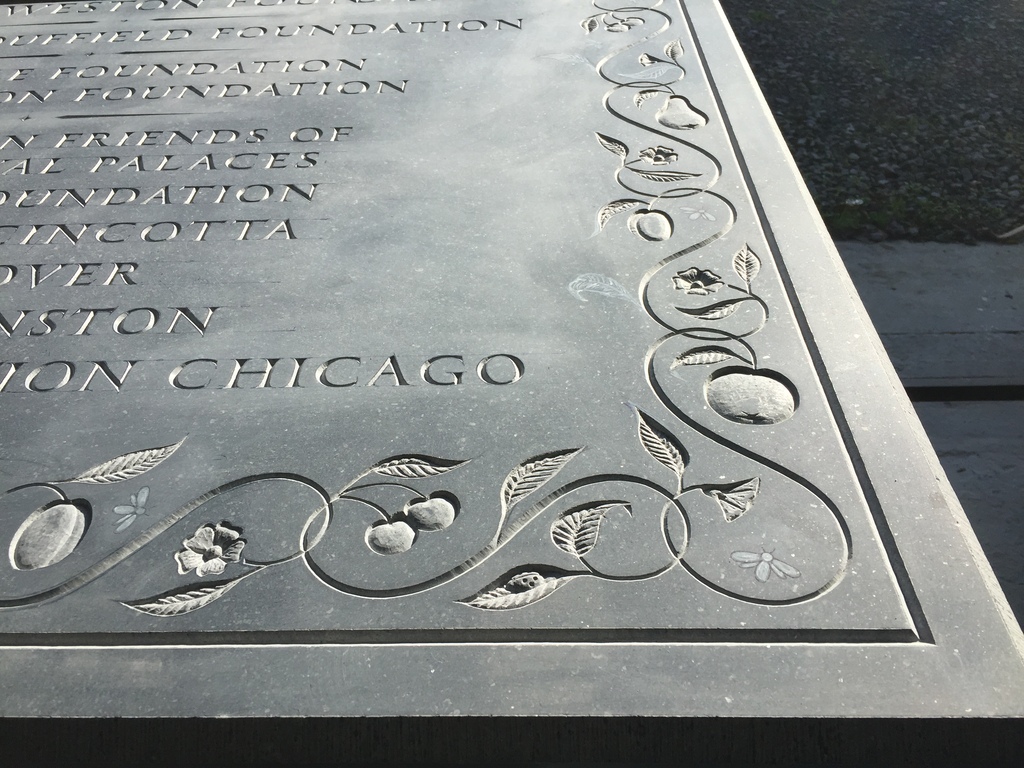
Floral-border-close-up
Often during the carving process, the client will visit the studio to see the progress.
The final part of the monumental process is installing the piece on site. There is a certain satisfaction in seeing the piece in its final resting place… Sometimes I have another headstone already in a particular cemetery and while I’m there I always go visit to see how it looks and reflect on the job. And ask myself the question are there things I’d change about it now? I think as an artist there is a constant evolution and it’s always good practice to check in on past work.
What does it mean to be a member of the Letter Carvers Guild?
I remember presenting my work to the letter carvers guild many years ago… It was after I had built up my own body of work, such as letterforms, memorials and commissions. It was a little daunting for me, but I was delighted to be accepted into the guild.
We have had some exhibitions over the years, where the aim was to promote the art of the carved letter and encourage each other to push boundaries and use different materials and letterforms. Each stone type brings out a different quality in the letters and you must adapt the letterforms to suit. The Guild is not as active as it once was and maybe it’s time for us, the younger generation coming through, to pick up the mantle and run with it.
Hillsborough Close-up
Is this art form going through a revival?
Somebody asked me about this the other day and in all honesty I would love to give you an outright yes, but it’s hard to know if there is a revival. It is certainly not a dying art. I have clients that only want hand cut letters and the people that come to me for a memorial have already made that choice.
Letter Carving is time consuming and requires patience and discipline. A lot of the skills for carving letters tend to lie with the hand sculptors. Carved letters are so very sculptural in their own right that often sculptors and carvers are compelled to master the art of the cut letter…. and as long as they do this, then letter carving will live on.
There are letter carving courses to be found in Ireland but there is a greater tradition in the UK especially with the likes of the Cardoza Kindersley studios. But If any of your readers are keen on taking up letter carving, a great book to get your hands on is, “The art of letter carving in stone” by Tom Perkins. I reference it all the time. This will give you a step by step approach on lettercarving. I have a studio copy with dog ears and loose pages falling out because of the number of times it’s been thumbed through.
Do you also need to be an excellent calligrapher?
It’s not essential to be an excellent Calligrapher, but it will help just to give a basic understanding of the structure of letters. I personally don’t work this way. I draw my letters with pencil on paper. Many letter cutters would have traditionally drawn or painted the inscription directly onto the stone, maybe working from a small sketch or layout of the inscription.
Take one piece and discuss it in relation to design.
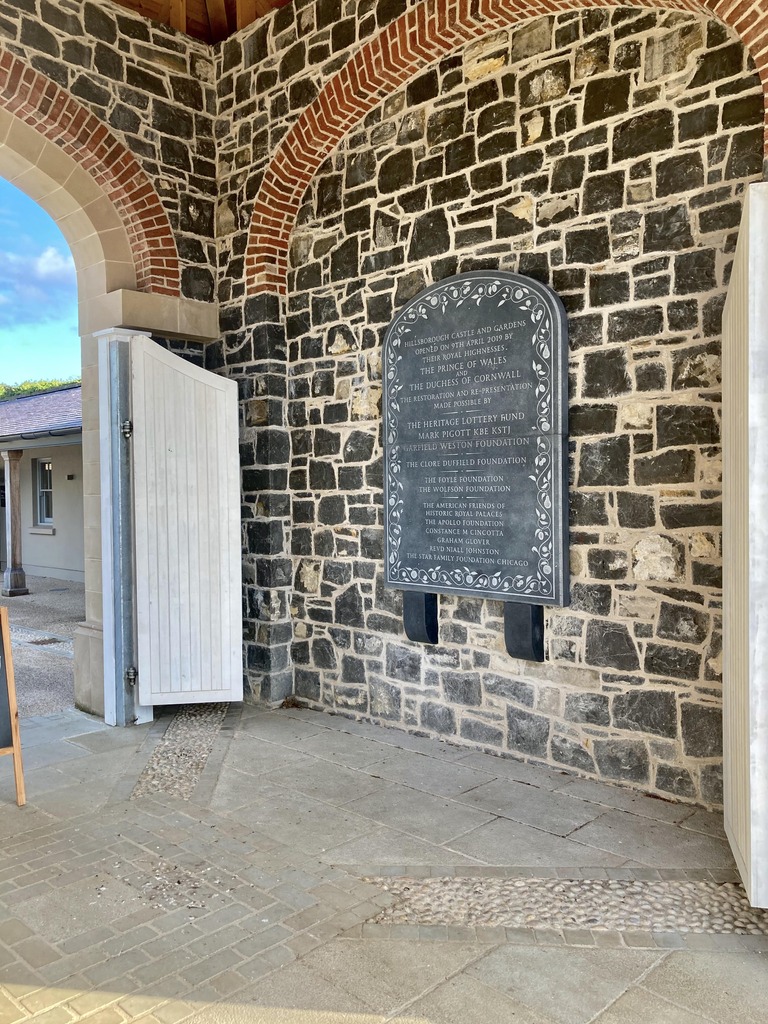
Hillsborough
In 2019, I was approached by the Historic Royal Palaces to create a large memorial inscription for Hillsborough Castle in Northern Ireland. The castle and walled gardens were re-opening its doors to the public and they wanted a stone inscription to mark the occasion and acknowledge the donors who made it possible.
My brief was to design this memorial for installation in the newly built gate lodge.
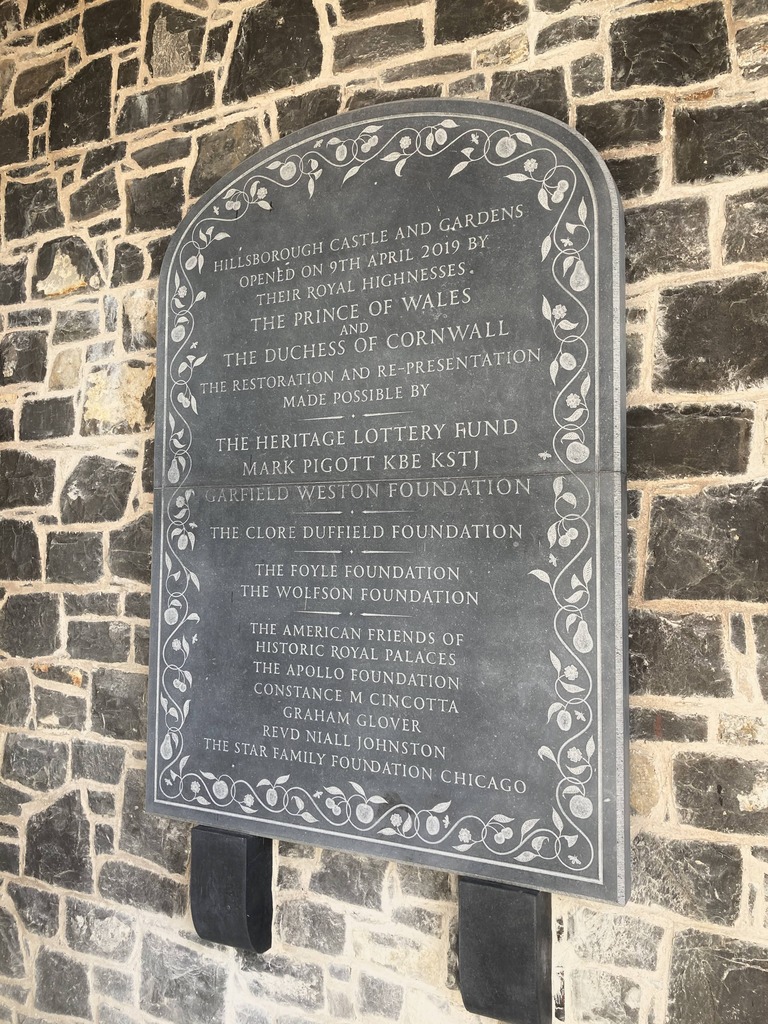
Hillsborough, Close up
I designed the shape of the stone tablet itself to mirror the arch of the gate lodge building where it was to be erected. I then laid out the inscription to sit within an intricate decorative floral border. This floral border was inspired by the native fruit trees in the walled garden at Hillsborough and contained elements such as apples, pears, plums, cherries and a few pollinators too. It was carved in Irish Limestone and measured 2.4 meters tall by 1.2 meters wide and contained about 450 characters.
I was working on it for months. The fruit border was really enjoyable to carve and I had to get the right balance between it and the inscription. If you look closely you will see little carved bees flying among the carved flowers. It was a wonderful commission to get, one of those commissions that only come around a few times in your lifetime.
Fruit-and-flower-test-piece
From the commissioning to the final placement of the work, are you under a strict timeline?
Sometimes yes, there is a deadline for a piece to be completed. It tends to be an anniversary or a significant date. Sometimes people come late in the day with a date and it is not possible. Things carved in stone take time to do right. Even just ordering a block from a stone yard can take 4-6 weeks lead in, from the time you order to have the stone in your studio.
Seminibus
Your sculptures are very dependent on the natural world, discuss.
When it comes to my own sculptural work, the natural world is a huge inspiration. I spend a lot of time in nature, I am forever picking up seed pods, shells, nuts and natural oddities. I love the textures and shapes and I reckon that mother nature is an infinite resource for all artists. Every season has something to offer and every year I wonder how I hadn’t spotted something that I just discovered, before now.
Comment on the importance having your work in the grounds of Áras an Uachtaráin, as an Irish sculptor.
Having my work at the president house is a massive honour, I can’t believe that my two pieces have been there over 10 years now. This was my first public commission and was commissioned by President Mary McAleese through the OPW. It was one of the last things she did before finishing her time in office.
It was a really important learning experience for me too, I think it’s a tough thing as an artist starting out. If you are going for commissions, there is a bit of a chicken and egg situation going on. You can’t get a commission if you haven’t got commission experience and you can’t get the experience if you don’t get commissioned.
Throughout this commission I gained invaluable experience. It allowed me to see what size and scale were possible within certain budgets while working with foundries and stone yards, making sure that you as the artist get paid too. It really brought a new level of professionalism to my practice and gave me a greater understanding of the amount of administration involved in dealing with commissioning bodies.
The brief was to create new works for a sensory border at Aras an Uachtarain. I was one of five artists shortlisted and I created maquettes for 3 pieces, 2 of which were commissioned, “The Braille alphabet” and “The Bronze bluebells”.
The braille alphabet consists of 3 Limestone panels 2 meters tall by 50 cm wide. Each of the 26 letters of the alphabet are carved into them, large 20cms tall V-cut letters.
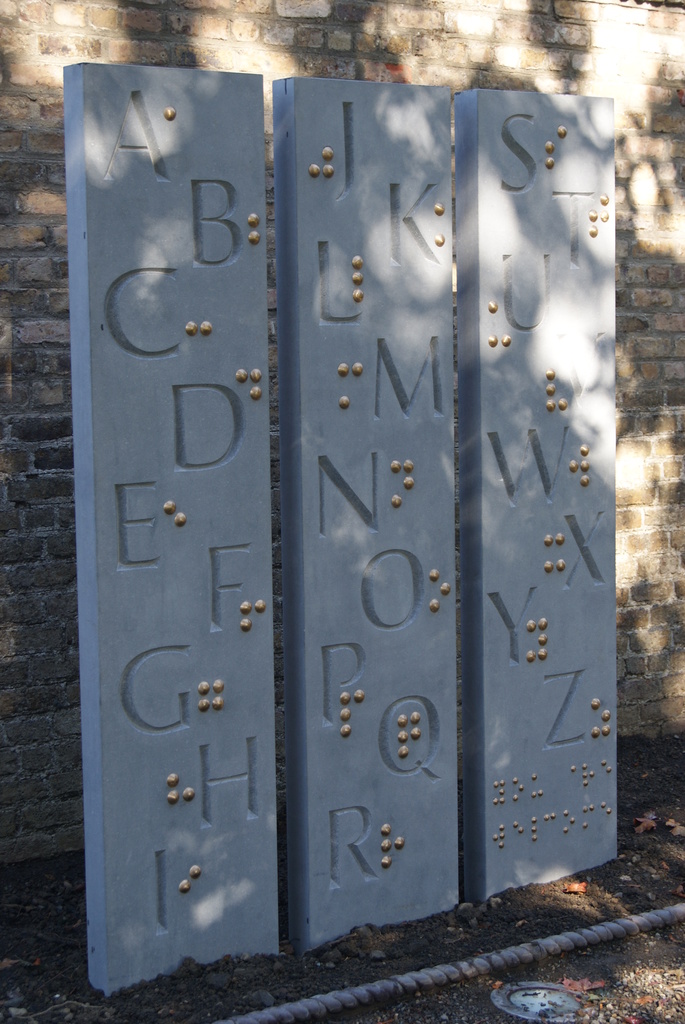
Braille-Alphabet
Each letter has its equivalent braille in bronze next to it or around it. The idea behind it was to let someone who was visually impaired or unsighted run their fingers through the v-cut letter and get a greater understanding of the structure of each of the letters. The same for someone who had no previous exposure to braille, they could experience it. It was my first full alphabet too which was really nice… When you carve letters that large they take on a real sculptural quality and there is something wonderfully satisfying to carving them.
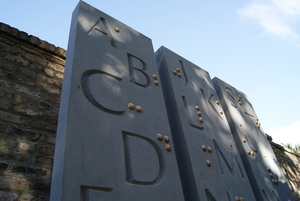
Braille-Alphabet, close up
The Bronze Bluebells sculpture was dealing with the sense of sound. It consisted of 7 individual bronze bluebells, each of a differing size.
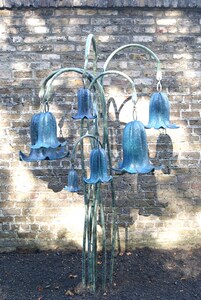
Bluebells
They were hung from 7 bronze stalks (2.5meters tall) and each fitted with a ringer. I modelled each bluebell individually and directly in wax and they were cast using the lost wax method. Each of the bells had a blue patina and made a wonderful sound when they rang.
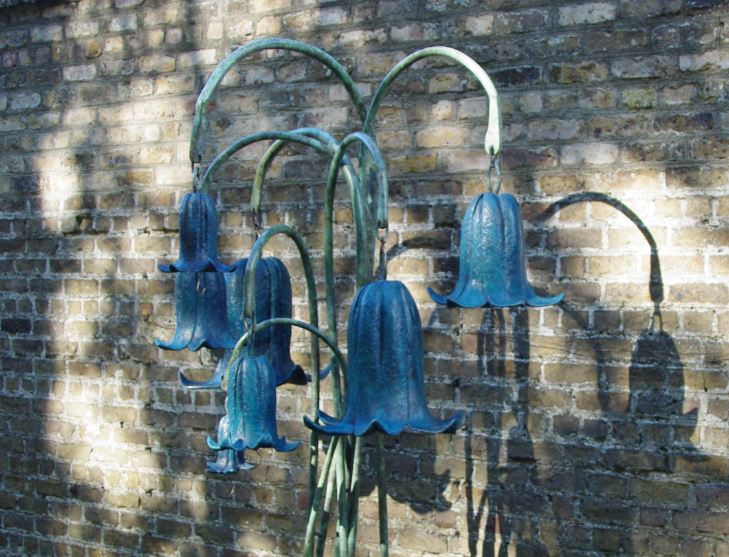
Bluebells, close up
In charge of the foundry where I cast them at that time was a man called Leo Higgins. I had a good relationship with him and he had taught me for a time in college. Leo was a character and a great artist and I will always be grateful for his kind nature and guiding hand throughout the casting process.
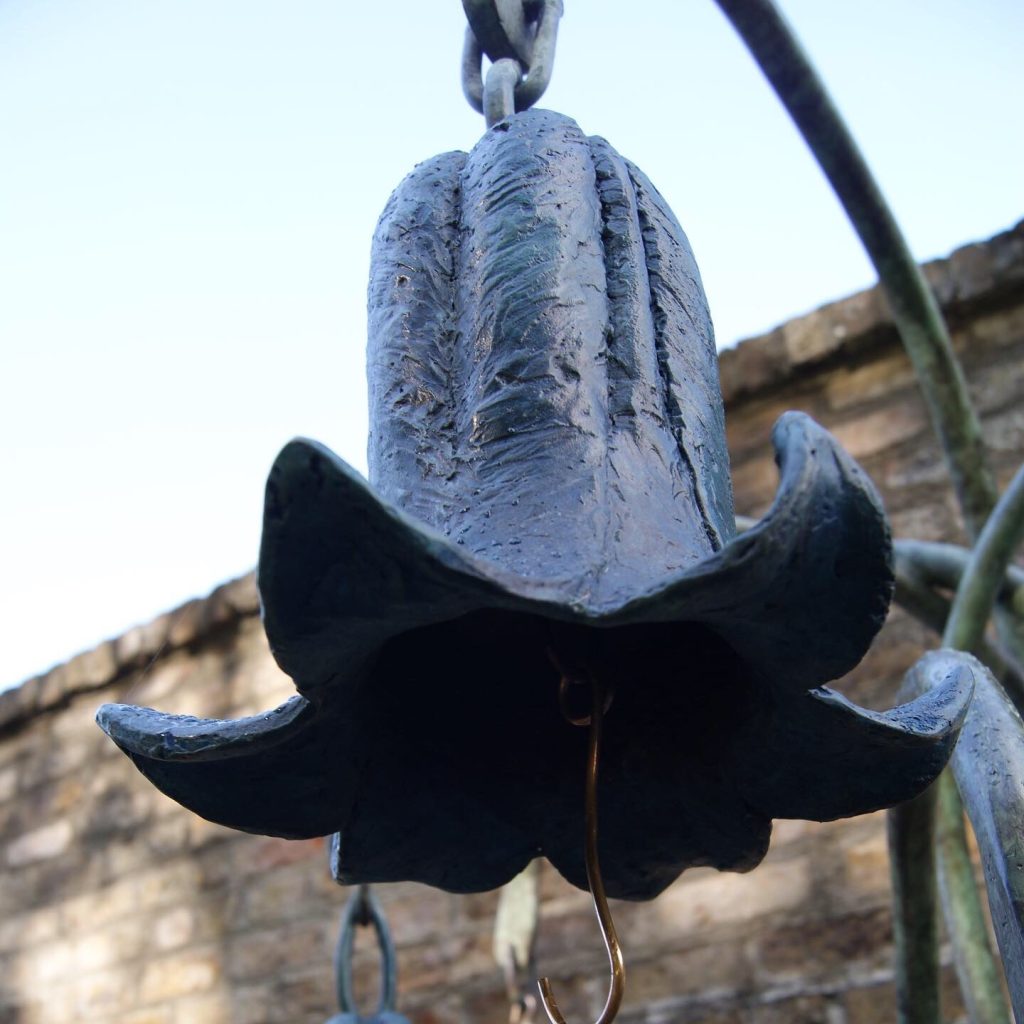
President, Michael D Higgins ringing the bells.
I was sent a photograph by someone who had attended a garden party at Aras an Uachtarain recently, of our current President, Michael D Higgins ringing the bells.
Explain about ‘Sculpture in Context’ and your work there.
Sculpture in context is the largest annual outdoor sculpture exhibition in Ireland. It’s been running for over 35 years and was set up by artists for artists. It has had many venues over the years but it currently resides in the National botanic Gardens of Ireland. The gardens have been hosting the show for over 20 years and it’s been a great marriage.
I was a member of the organising committee of Sculpture in context for about 8 years. This was the first show that I ever exhibited in. I was buoyed by that experience and I went on to submit work for it every year since. It’s the reason why I wanted to give back and get involved in the organisation of the show. I have made some great friendships through this exhibition from committee members to meeting other artists to meeting gallerists and clients.
I have sold work, won awards and been commissioned through this exhibition. I really like the mix of the artists involved every year, from new graduates to established artists and to everyone in between. It’s a really important date on the artistic calendar for me each year.
Tell us about one of your sculptures in Taiwan representing Ireland and UK artists.
This show was really interesting. I was approached by the curator to participate in a show that was taking place in Taiwan. It was a great opportunity to have some of my work exhibited overseas, so I jumped at the chance. I sent some images to the curator of the show of my available work. They picked three pieces and I boxed them up for collection. There were some really top names in the exhibition too, like Peter Randall-Page. I never got to travel to the exhibition purely because of financial constraints but the participating Irish artists all met with the Taiwanese ambassador for lunch in Dublin. All the artists were at different stages in our careers and there were some interesting conversations.
The one piece which I sent that stood out for me was a piece I had carved from Irish Limestone, entitled Corolla.
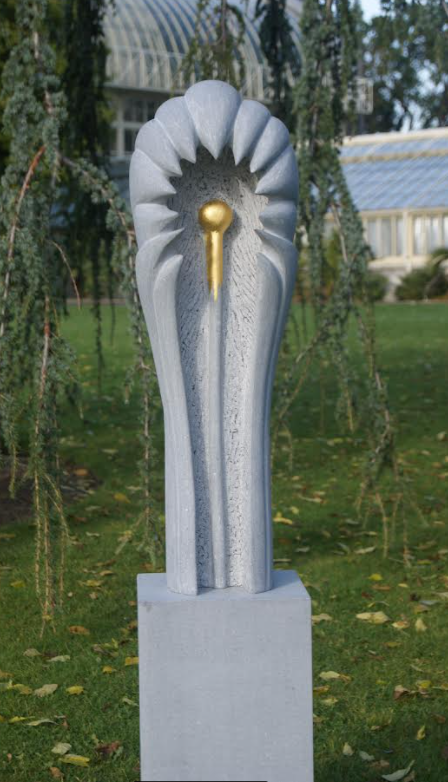
Corolla
This was a really important piece for mycorolla own development as a carver. It has an element of danger portrayed in it. There is a gilded stamen and it’s protected by these carved stone dentata. I sold the other works at the show but this one returned to me. I have it in my own garden and recently re-gilded it. I like the way it travelled halfway around the world and has come back to me.
Take one large and one small sculpture, that has given you great pleasure while sculpting it and why?
For the large sculpture I’m going to say a piece from about two years ago, called “Strippeas”.
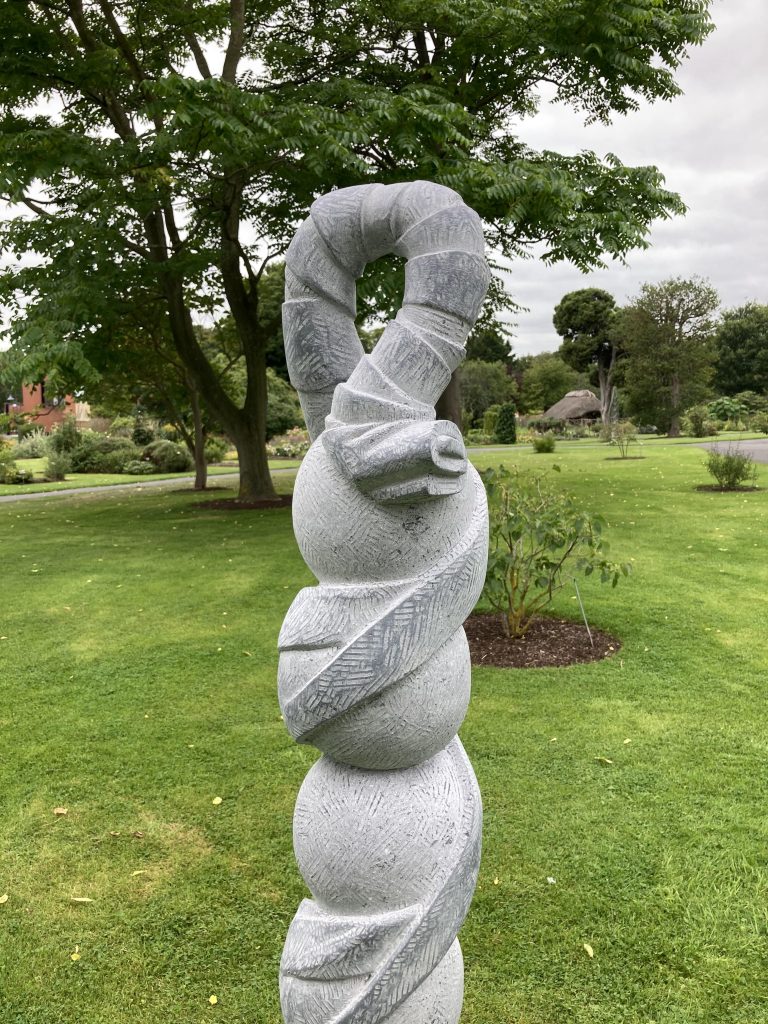
Strippeas
It was a 1.6mt tall Kilkenny limestone sculpture. I have been carving peapods for a number of years and this piece is an evolution of this theme. I have visited this subject matter a number of times and each time I finish one I think that’s it now, but then a notion drops into my head or I have a flick through an old notebook and see an old sketch and it triggers the next avenue of exploration with this theme…
This piece represents a skinned peapod with the skin wrapped background itself like drapery. I had a faint notion of Saint Bartholomew at Milan Cathedral in which his flayed skin has been removed, “Senza pelle” as they say in Italy to reveal his muscles and tendons. His skin has then been wrapped around him like a piece of cloth or a toga.
My piece is a bit less gorey and just a bit of fun. It gave me a chance to explore my peapod theme and experiment with some drapery and create something with a little backstory. It was a large enough piece for me to really get stuck in and enjoy the process. It picked up a stone carving prize at sculpture in context in 2021.
The smaller sculpture, I am going to say a Portrait sculpture of my father in law, it’s a lesser known side of my practice.

In recent years I have been working in clay more and more and I’ve built up a number of portrait studies. But this one stands out as most memorable as an experience. It was during the height of covid lockdowns and I had no access to my studio, tools or stone. I did have a large bag of clay lying around and I asked my father in law to be a sitter for me, so I could model his portrait. Each day he would sit for about 90 minutes and I would build up his likeness in clay. He was about 84 yrs old at the time. I was mindful not to have him sit for too long, but over about 10 days or so he would sit up on the chair and I’d get out the portrait bust and work away modelling. Meanwhile he told stories about life as a boy growing up in Crossmolina. This is a little village in County Mayo in the west of Ireland. I had heard some of the stories already but there were some real gems in there, a few salty ones too but they’ll have to stay with me. It’s a bit like a doctor/patient confidentiality agreement..
There is something really enjoyable about this aspect of portraiture, the rapport that is built up between artist and sitter. As the artist you hope that you bring some of the personality of the person to the portrait.
The rest of the family and I were really happy with the portrait and I had it cast in bronze and we presented it to him at his 85th birthday. Immortalised in bronze.
Contact:
Richard Healy
www.richardhealysculptures.com
Instagram. richie_healy_sculptures
email. richiehealy@gmail.com
Deborah Blakeley, Melbourne, Australia
Interview by Deborah Blakeley, June 2023
Think a colleague or friend could benefit from this interview?
Knowledge is one of the biggest assets in any business. So why not forward this on to your friends and colleagues so they too can start taking advantage of the insightful information the artist has given?
Other artists you may be interested in:



